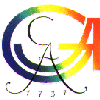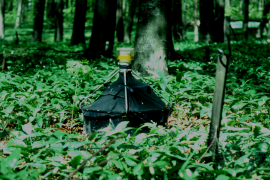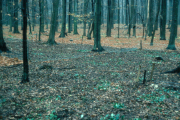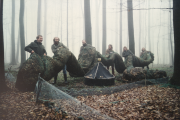Institute of Zoology and Anthropology
Klaus Hövemeyer

|
Ecology Research Group
Institute of Zoology and Anthropology Klaus Hövemeyer |

|
|
Research Interests
Ecology of soil-dwelling Diptera
Diptera larvae are poorly studied members of the soil fauna. 
Since extraction of larvae is so laborious, emergence traps have been widely employed to catch adult Diptera after emergence. These traps are tent-like constructions with a collecting vial at the top and highly efficient in capturing insects emerged from the soil. Hence, catches from such traps reflect the performance of larval populations. There is a further advantage to emergence trap studies: in contrast to most larvae, adults can be identified to species, and it is not uncommon to find new species of Sciaridae (e.g., Hövemeyer 1989). I have reviewed results from such emergence trap studies conducted in various terrestrial habitats (Hövemeyer 1991, 1999b): Most studies (75%) reported annual emergence abundances of Diptera between 1000 and 4000 individuals per square metre. So there is probably little point in employing emergence traps for the mere purpose of measuring abundances. I would rather recommend to use them for analyses of community structure and diversity (e.g., Hövemeyer 1999a).  The litter manipulation experiment comprised plots from which canopy litter input was removed in autumn 1981 and 1982., plots on which litter input was increased to fivefold the normal amount, plots from which the above-ground parts of herbs were removed, and control plots. These plots were sampled for four years. The litter manipulation experiment comprised plots from which canopy litter input was removed in autumn 1981 and 1982., plots on which litter input was increased to fivefold the normal amount, plots from which the above-ground parts of herbs were removed, and control plots. These plots were sampled for four years. With respect to Diptera, abundances appeared to be influenced in a bottom-up manner, i.e., they were usually higher on the multiplication plots, but differences in litter layer structure which incurred different moisture regimes on the plots, also seemed to be important. On the multiplication plots, species composition of Sciaridae changed with time, suggesting that individual species responded to the varying amounts of leaf litter of different age and, hence, food quality (Hövemeyer 1987, 1992). With respect to Diptera, abundances appeared to be influenced in a bottom-up manner, i.e., they were usually higher on the multiplication plots, but differences in litter layer structure which incurred different moisture regimes on the plots, also seemed to be important. On the multiplication plots, species composition of Sciaridae changed with time, suggesting that individual species responded to the varying amounts of leaf litter of different age and, hence, food quality (Hövemeyer 1987, 1992).
You can find more details on studies of the community ecology of Diptera by clicking the respective link in the green box. Selected Publications HEALEY, I.N. & RUSSELL-SMITH (1979) The extraction of fly larvae from woodland soils. Soil Biology and Biochemistry 2:119-129. HÖVEMEYER, K. (1999a): Diversity patterns in terrestrial dipteran communities. Journal of Animal Ecology 68: 400-416. HÖVEMEYER, K. (1999b): Abundance patterns in terrestrial dipteran communities. Pedobiologia 43: 28-43. HÖVEMEYER, K. (1992): Response of Diptera populations to experimentally modified leaf litter input in a beech forest on limestone. Pedobiologia 36: 35-49. HÖVEMEYER, K. (1984): Die Dipterengemeinschaft eines Buchenwaldes auf Kalkgestein: Produktion an Imagines, Abundanz und räumliche Verteilung insbesondere der Larven. Pedobiologia 26: 1-15. HÖVEMEYER, K. (1991): The study of dipterous populations and communities in European terrestrial ecosystems. In: WEISMANN, L., ORSZAGH, I. & PONT, A.C. (eds): Proceedings of the Second International Congress of Dipterology: 99-109. SPB Academic, The Hague. HÖVEMEYER, K. (1989): Bradysia drakenbergensis, spec. nov., eine neue Sciaridenart aus dem südniedersächsischen Bergland (BRD). Spixiana 12: 209-211. HÖVEMEYER, K. (1989): Der Einfluß von Streumenge und Streuqualität auf die Siedlungsdichte von Dipterenlarven: ein Freilandexperiment im Kalkbuchenwald. Verhandlungen der Gesellschaft für Ökologie 17: 229-236. HÖVEMEYER, K. (1987a): Reaktionen der Dipteren auf experimentell veränderten Laubstreufall in einem Buchenwald. Jahresberichte des Naturwissenschaftlichen Vereins in Wuppertal 40: 5-9. |
|